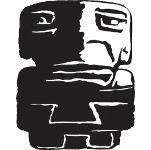Robin D. Laws's Blog, page 77
June 26, 2012
5 Things I Learned About Jack White...
...from this installment of Marc Maron’s WTF podcast:
If he really had to, he could still reupholster a chair.
Deciding that he needed to learn to cut loose while on tour, he started antiquing.
He owes his success to a fanatical interest in his field…
…and an obsessive work ethic.
The name of his former band The White Stripes is pronounced whitestripes, accent on the first syllable.
Whitestripes.
June 25, 2012
Super Caution
 Earlier I explained why the first DramaSystem game, Hillfolk, lacks super-powers, instead building its geek cred around iron age trappings.
Earlier I explained why the first DramaSystem game, Hillfolk, lacks super-powers, instead building its geek cred around iron age trappings.
For our second in-house DramaSystem series, I figured it was okay to bust out some more overtly fantastical elements. The group chose to play cast members in a traveling carnival during the Dustbowl era, and agreed that it would be okay to have supernatural powers of some sort.
Although they’re clearly happy to enjoy fantastical elements as a prospect, none of the players has seized on the narrative power the system grants them to give themselves the permissible super-abilities. Jo-Jo the Cat Faced boy has demonstrated himself to be an agile escape artist, but not this has not been described as in any way superhuman. If the carnival impresario, magician, aerialist or snake charmer have incredible powers up their sleeves, they have yet to reveal them.
As GM, I’ve introduced elements making it clear that they operate in a supernaturally heightened 1930s. They’ve learned that the carnival’s other aerialist can unfurl a prehensile tongue to drain young victims of blood. A young girl who can move objects with her mind just showed up seeking refuge. And manipulating events from a remove is a dapper man from the impresario’s past who might just be the devil.
Over the course of the series, we’ve discovered that he wants them to collect and protect others with extraordinary abilities, maneuvering Barboa the snake handler into a pact to this effect. The interest of the mysterious Mr. Ordogh may cement players’ reluctance to give their characters super-powers. But long before his scheme revealed itself, the dynamic was already manifest.
Given the chance to be super, the group decided they were just fine being people.
June 22, 2012
The League of Drowned Ghosts
 Tempest Rising, the latest installment of Paizo’s Skull & Shackles adventure path is now available. Among all manner of piratical Pathfindery goodness within its salt-scorched pages you will find “The League of Drowned Ghosts”, the next chapter of my serialized novella The Treasure of Far Thallai.
Tempest Rising, the latest installment of Paizo’s Skull & Shackles adventure path is now available. Among all manner of piratical Pathfindery goodness within its salt-scorched pages you will find “The League of Drowned Ghosts”, the next chapter of my serialized novella The Treasure of Far Thallai.
Follow Challys Argent and her complement of sinister sword-enslaved sidekicks as she follows a cyclopean confession to the titular isle of Drowningtide. There they find that the hospitality of unfortunates drowned at sea can be too pressing to refuse...
June 21, 2012
The Birds: Event
June 20, 2012
Video Interview with the Secret DM
 In this Gamerati interview, I talk Hillfolk, Stone Skin Press, Dreamhounds of Paris, Hamlet’s Hit Points, and our plan to apprehend Flattop, with David Melmo, the Secret DM. Check out his lovely intro, subscribe to Ed Healy’s Gamerati YouTube channel, or dive in directly below.
In this Gamerati interview, I talk Hillfolk, Stone Skin Press, Dreamhounds of Paris, Hamlet’s Hit Points, and our plan to apprehend Flattop, with David Melmo, the Secret DM. Check out his lovely intro, subscribe to Ed Healy’s Gamerati YouTube channel, or dive in directly below.
June 19, 2012
New Hero Brief: Story Requirements
 With Stone Skin Press’ first books headed for pre-release roll-out, I thought you might enjoy a look inside the process, at the brief I sent out when inviting contributors to take part in The New Hero (and its later follow-up, The New Hero Volume 2). I’ll be breaking these up into blog-sized bites over the next few days. Please note that this is not a call for contributions; the books are finished and ready for the printer, the invited authors having delivered some exciting work featuring their new and newish iconic characters.
With Stone Skin Press’ first books headed for pre-release roll-out, I thought you might enjoy a look inside the process, at the brief I sent out when inviting contributors to take part in The New Hero (and its later follow-up, The New Hero Volume 2). I’ll be breaking these up into blog-sized bites over the next few days. Please note that this is not a call for contributions; the books are finished and ready for the printer, the invited authors having delivered some exciting work featuring their new and newish iconic characters.
The previous installment defined the unifying structure the books revolve around. Here’s what I asked contributors to do with the theme when writing their stories.
Your story must show us everything about the hero and his environment that we need to know to understand the action. If you can imply that we’re following one of the hero’s many similar adventures, so much the better. Check out a Sherlock Holmes or Conan story to see how the classic authors of iconic serial fiction efficiently introduced their heroes and then got on with the story at hand.
Possible genres include: epic fantasy, sword and sorcery, urban fantasy, space opera, mystery, occult investigation, hard-boiled action, super heroes, pulp, special forces, espionage, gothic intrigue, steampunk, cyberpunk, and historical derring-do. This is not an exhaustive list. Surprise me. Not fitting an immediately identifiable genre is cool, too.
Likewise, feel free to set your story in the past, present or future, in this world or on an imaginary one.
We’re looking for a mix of genres so the more distinctive your choice of genre, the easier time I’ll have deciding which of the two volumes it fits in. Pick the genre you most feel at home in or that best inspire you to create a new iconic hero.
We need female as well as male heroes.
Solo protagonists are easiest to introduce and follow, but other configurations are acceptable, so long as one of them is an iconic hero. You might have your iconic hero/sidekick combo, as per Holmes and Watson, or a duality of iconic heroes, like Mulder and Scully. A team of equally iconic heroes would be hard to pull off, given space constraints, but could work.
We seek self-contained adventures featuring already iconic heroes, not origin stories in which a character undergoes a dramatic arc to become an iconic hero at the end.
We’d be happy to see further adventures of heroes you’ve featured in previous published stories. provided that they meet the iconic criteria, or can be presented as iconic heroes for the length of your story. (You might for example write a standalone adventure of a character who remains unchanged throughout but undergoes a dramatic arc elsewhere in your work.) It goes without saying that you must own the underlying rights for any existing characters (or settings) you wish to feature.
What We’re Not Looking For
As noted above, ixnay on the origin stories.
Engage the premise head-on. We’re not looking for stories that subvert, invert, deconstruct, parody, ironically riff on, or otherwise take the mickey out of the concept of the iconic hero.
Humor is okay within the context of a heroic story but we’re not looking for pieces that are predominantly spoofy.
Please don’t propose new adventures of preexisting heroes created by other authors, even if you have secured the rights to them. We are likewise not looking for new adventures of public domain heroes. Nor are we seeking Solar Pons-styles pastiches in which the names and serial numbers have been filed off of classic iconic heroes.
We’re not looking to reprint previously published stories.
June 18, 2012
New Hero Brief: What Makes an Iconic Hero?
 With Stone Skin Press’ first books headed for pre-release roll-out, I thought you might enjoy a look inside the process, at the brief I sent out when inviting contributors to take part in The New Hero (and its later follow-up, The New Hero Volume 2). I’ll be breaking these up into blog-sized bites over the next few days. Please note that this is not a call for contributions; the books are finished and ready for the printer, the invited authors having delivered some exciting work featuring their new and newish iconic characters.
With Stone Skin Press’ first books headed for pre-release roll-out, I thought you might enjoy a look inside the process, at the brief I sent out when inviting contributors to take part in The New Hero (and its later follow-up, The New Hero Volume 2). I’ll be breaking these up into blog-sized bites over the next few days. Please note that this is not a call for contributions; the books are finished and ready for the printer, the invited authors having delivered some exciting work featuring their new and newish iconic characters.
Unlike other anthologies united by theme or genre, The New Hero books ask writers to present material from any genre using a common structure. Here is how I presented that to the authors. Long-time readers of this blog may recognize the key concepts and examples.
The New Hero is an anthology of original fiction featuring new iconic heroes, edited by Robin D. Laws and published by Pelgrane Press.
It will consist of 14 stories, each 4500-7500 words long.
Each story features an iconic hero of the author’s creation, in any genre. The hero is presented with a problem, faces various entertaining complications as he or she engages with the problem, and solves the problem, bringing the story to a satisfying conclusion. The reader is thus left hungering for more stories starring your newly introduced iconic character. What Makes a Hero Iconic
While a dramatic hero follows a character arc in which he is changed by his experience of the world (examples: Orpheus, King Lear, Ben Braddock), an iconic hero undertakes tasks (often serially) and changes the world, restoring order to it, by remaining true to his essential self.
Prevailing creative writing wisdom favors the changeable dramatic character over his serially unchanging iconic counterpart, but examples of the latter remain enduring tentpoles of popular culture. It’s the clear, simple, elemental iconic heroes who keep getting reinvented every generation. Each such classic character spoke to the era of its invention, while also evoking an eternal quality granting it a continuing resonance. We are going to create a new set of heroes who speak to the contemporary world while evoking the inescapable power of the iconic model.
An iconic hero re-imposes order on the world by reasserting his essential selfhood. The nature of his radical individuality can be summed up with a statement of his iconic ethos. It is the ethos that grants higher meaning to the hero’s actions, and a clue to his creator’s intentions. An iconic hero’s ethos motivates and empowers him.
Sherlock Holmes solves mysteries using rigorous deductive logic.
Miss Marple solves mysteries with a sharp mind, hidden behind a deceptively doddering demeanor.
Conan uses his barbaric superiority to overturn the false order of corrupt civilization.
Carnacki the Ghost Finder conquers fear with scientific methodology and technology.
Dr. Gregory House caustically tramples social decencies to solve medical mysteries, temporarily assuaging his self-loathing.
Batman brings justice to cowardly and superstitious wrongdoers, doing for others what he could not do for his murdered parents.
Storm overcomes the enemies of human- and mutantkind by wielding nature’s untamed power.
James Bond dispatches Britain's enemies with cold suavity and violence.
Tarzan upholds the noble values of the jungle against the predatory outsiders who would despoil it.
Philip Marlowe goes down mean streets, without himself becoming mean.
An iconic ethos implies both action and motivation. Each adventure featuring the hero is a satisfyingly ritualistic recapitulation of the character’s core action. By engaging in this recapitulation the hero restores the sense of order which was disrupted by the problem presented at the narrative’s outset.
This anthology provides your chance to create your Bond, your Batman, your Philip Marlowe.
Next: What we wanted to see in submitted stories—and what we didn’t.
June 15, 2012
The Sleeper Gene
 Remote controlled gene activation fuels a pharmaceutical conspiracy in my latest installment of StoryCraft, over at the Ancient Scroll.
Remote controlled gene activation fuels a pharmaceutical conspiracy in my latest installment of StoryCraft, over at the Ancient Scroll.
June 14, 2012
The Birds: Meditation
June 13, 2012
The Dying Earth Revivification Folio Now Available For Pre-Order
 In Jack Vance’s stories of the Dying Earth, the sun, and thus life itself, is universally thought to be mere moments from a sad, smoldering demise. Yet inexplicably it continues to shine, allowing the world's hyper-verbal denizens to go on swindling and pettifogging one another. This is faster and more fun than ever before with the Dying Earth Revivification Folio now available for pre-order from Pelgrane Press.
In Jack Vance’s stories of the Dying Earth, the sun, and thus life itself, is universally thought to be mere moments from a sad, smoldering demise. Yet inexplicably it continues to shine, allowing the world's hyper-verbal denizens to go on swindling and pettifogging one another. This is faster and more fun than ever before with the Dying Earth Revivification Folio now available for pre-order from Pelgrane Press.
My brief with this book was to create what was in effect a new edition of the game, bringing it the improvements to the basic system we built into Skulduggery, the streamlined, generic game based on the original DERPG core rules. The goal however was not to render your purchase of the original game obsolete, but to serve as a booster kit for it. It is neither game nor supplement, then, but rather a gupplement.
Wait. That’s terrible. Forget I said that.
When you think about it, really what’s happening is that DERF is now the game, and has also retroactively turned DERPG into a supplement.
Wait, never mind that either. Semantics are the cutlass of the pettifogger.
We are sometimes told that DERPG is a buyer’s favorite game he can’t get his players to try. The Revivification Folio solves that problem for you by adopting the super-fast, card-based character generation system first presented in Skulduggery. Players can jump right in without undergoing the more traditionally detailed character creation process mooted in the original book. Within minutes they are decisively ensnared.
The quick and deadly combat system is now quicker and just as unforgiving.
Magic is simplified so that the spells you wield appear on cards. In true Vancian fashion, you play the card and have used up the spell. Enchanted items can be used multiple times but are likewise presented in easy-to-use card format.
The book comes with cards to generate your first six PCs, and with notes on replacing them when they succumb to the cruelties of a decadent world.
Also included are your first three scenarios: one in which our picaresque heroes find themselves unwillingly indentured to a hotelier-slash-arch-magician, another in which they serve as guardians to a tomb-raiding expedition, and another in which they finally secure sinecures as officials in a bucolic rural village. Nothing could possibly go wrong!





